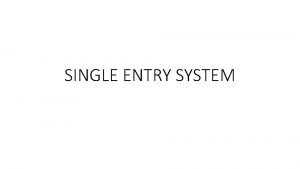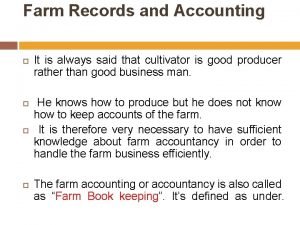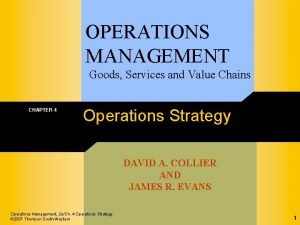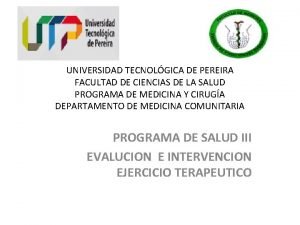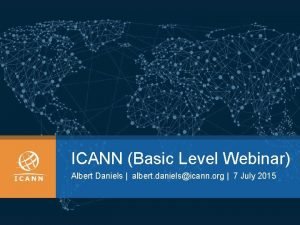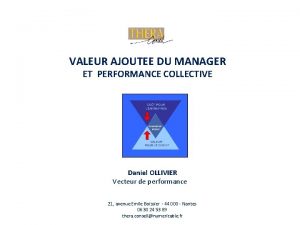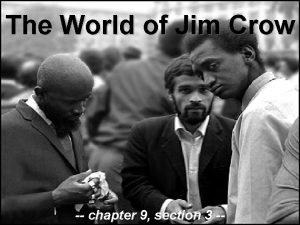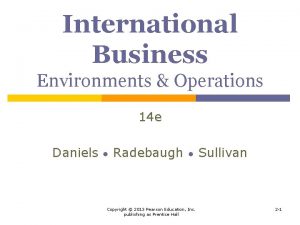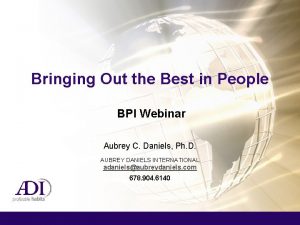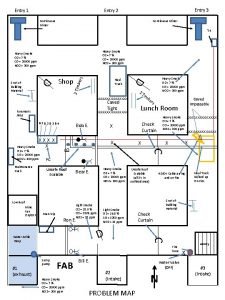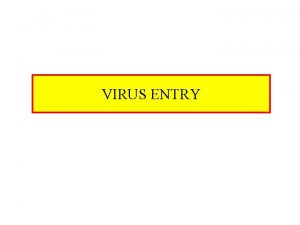Chapter 14 Hill Chapter 11 Daniels Entry Strategy





















- Slides: 21

Chapter 14 (Hill) & Chapter 11 (Daniels) Entry Strategy and Strategic Alliances

What Are The Basic Decisions Firms Make When Expanding Globally? Ø Firms expanding internationally must decide 1. Which markets to enter Ø depends on long run profit potential Ø favorable markets are politically stable, have free market systems, have relatively low inflation rates, and have low private sector debt Ø less desirable markets are politically unstable, have mixed or command economies, and have excessive levels of borrowing 15 -2

What Are The Basic Decisions Firms Make When Expanding Globally? 2. When to enter them and on what scale Ø must consider the timing of entry Ø first mover advantages and disadvantages Ø the scale of market entry Ø strategic commitment 3. Which entry mode to use Ø exporting Ø licensing or franchising to a company in the host nation Ø establishing a joint venture with a local company Ø establishing a new wholly owned subsidiary Ø acquiring an established enterprise 15 -3

How Can Firms Enter Foreign Markets? Ø These are six different ways to enter a foreign market 1. Exporting – a common first step for many manufacturing firms Ø later, firms may switch to another mode 2. Turnkey projects - the contractor handles every detail of the project for a foreign client, including the training of operating personnel Ø at completion of the contract, the foreign client is handed the "key" to a plant that is ready for full operation 15 -4

How Can Firms Enter Foreign Markets? 3. Licensing - a licensor grants the rights to intangible property to the licensee for a specified time period, and in return, receives a royalty fee from the licensee Ø patents, inventions, formulas, processes, designs, copyrights, trademarks 4. Franchising - a specialized form of licensing in which the franchisor not only sells intangible property to the franchisee, but also insists that the franchisee agree to abide by strict rules as to how it does business Ø used primarily by service firms 15 -5

How Can Firms Enter Foreign Markets? 5. Joint ventures with a host country firm a firm that is jointly owned by two or more otherwise independent firms Ø most joint ventures are 50: 50 partnerships 6. Wholly owned subsidiary - the firm owns 100 percent of the stock Ø set up a new operation Ø acquire an established firm 15 -6

Which Entry Mode Is Best? Advantages and Disadvantages of Entry Modes 15 -7

How Do Core Competencies Influence Entry Mode? Ø The optimal entry mode depends on the nature of a firm’s core competencies Ø When competitive advantage is based on proprietary technological know-how Ø avoid licensing and joint ventures unless the technological advantage is only transitory, or can be established as the dominant design Ø When competitive advantage is based on management know-how Ø the risk of losing control over the management skills is not high, and the benefits from getting greater use of brand names is significant 15 -8

How Do Pressures For Cost Reductions Influence Entry Mode? Ø When pressure for cost reductions is high, firms are more likely to pursue some combination of exporting and wholly owned subsidiaries Øallows the firm to achieve location and scale economies and retain some control over product manufacturing and distribution Øfirms pursuing global standardization or transnational strategies prefer wholly owned subsidiaries 15 -9

Which Is Better – Greenfield or Acquisition? Ø The choice depends on the situation confronting the firm 1. A greenfield strategy - build a subsidiary from the ground up Ø a greenfield venture may be better when the firm needs to transfer organizationally embedded competencies, skills, routines, and culture 15 -10

Which Is Better – Greenfield or Acquisition? 2. An acquisition strategy – acquire an existing company Ø acquisition may be better when there are well-established competitors or global competitors interested in expanding Ø The volume of cross-border acquisitions has been rising for the last two decades 15 -11

What Are Strategic Alliances? Ø Strategic alliances refer to cooperative agreements between potential or actual competitors Ørange from formal joint ventures to short-term contractual agreements Øthe number of strategic alliances has exploded in recent decades 15 -12

Why Choose Strategic Alliances? Ø Strategic alliances are attractive because they Ø facilitate entry into a foreign market Ø allow firms to share the fixed costs and risks of developing new products or processes Ø bring together complementary skills and assets that neither partner could easily develop on its own Ø help a firm establish technological standards for the industry that will benefit the firm Ø But, the firm needs to be careful not to give away more than it receives 15 -13

What Makes Strategic Alliances Successful? Ø The success of an alliance is a function of 1. Partner selection Ø A good partner Ø helps the firm achieve its strategic goals and has the capabilities the firm lacks and that it values Ø shares the firm’s vision for the purpose of the alliance Ø will not exploit the alliance for its own ends 15 -14

What Makes Strategic Alliances Successful? 2. Alliance structure Ø The alliance should Ø make it difficult to transfer technology not meant to be transferred Ø have contractual safeguards to guard against the risk of opportunism by a partner Ø allow for skills and technology swaps with equitable gains Ø minimize the risk of opportunism by an alliance partner 15 -15

What Makes Strategic Alliances Successful? 3. The manner in which the alliance is managed Ø Requires Ø interpersonal relationships between managers Ø cultural sensitivity is important Ø learning from alliance partners Ø knowledge must then be diffused through the organization 15 -16

Pressure for Global Integration Different Strategies for Operating International Market High Global Transnational View the world as a single market. Tightly controls global operation from headquarter to preserve focus on standardization Prefers a flexible value chain to facilitate local demand. Adopts complex coordination mechanism to facilitate global integration International Low Uses existing core competencies to exploit opportunities in foreign markets Multidomestic Relies on foreign subsidiaries operating as autonomous units to customize products and processes for local market High Low Pressure for National Responsiveness 15 -17

International Strategy Ø R&D or branding being developed centrally Ø Try to create value by transferring core competencies and unique product where rivals are unable to develop, match and sustain Ø Does not push local responsiveness Ø Limitation: ØCentral role of headquarter often hinder identifying and responding local condition ØThis become costly when the local company emphasize customization based on local demand 15 -18

Multidomestic Strategy Ø Meet need of individual country and region basis Ø Respond to local culture, legal policy and economic environment Ø Can add value if local government give incentive for local plant Ø Local company can build sales force if there is unfavorable environment Ø Managers follow polycentric view Ø Limitation: Ø Can lead to duplication of management, design, production and marketing Ø Subsidiary is a virtual stand-alone operation, so headquarter must resort persuasion for any change 15 -19

Global Strategy Ø Create product or service for a world market, manufacture them on a global scale in a few highly efficient plants, and market them with few focused distribution channel Ø Aim to become low cost player in the market Ø Place R&D, production and marketing in most favorable location Ø Firms that follow global strategy face strong pressure for cost reduction but weak pressure for local responsiveness Ø Large operation helps to give standard product in a low price 15 -20

Transnational Strategy Ø Exploit location economies, leverage core competencies and pay attention to local responsiveness Ø Differentiate capability and contributions from country to country Ø Learn various knowledge (operation, finance, technology, creative idea), integrate and defuse them in global operation Ø Combine the market sensitivity of local responsiveness with the competitive efficiency of global integration Ø Limitation: Ø Difficult to build and prone to shortfall 15 -21
 New entry entrepreneurship
New entry entrepreneurship Annuity method
Annuity method Distinguish between single entry and double entry
Distinguish between single entry and double entry Hill's strategy development framework
Hill's strategy development framework Dermatomas
Dermatomas There are millions of stars in the space
There are millions of stars in the space Travel tracer literature circles
Travel tracer literature circles Albert daniels
Albert daniels Daniels fund scholar portal
Daniels fund scholar portal Rita daniels nurse
Rita daniels nurse Mrs daniel ap stats
Mrs daniel ap stats Performance management daniels
Performance management daniels Lige daniels
Lige daniels International business daniels 15th edition ppt
International business daniels 15th edition ppt Albert daniels net worth
Albert daniels net worth 70 jahrwochen daniels
70 jahrwochen daniels Dharius daniels bloodline prayers
Dharius daniels bloodline prayers Daniels bengtsson
Daniels bengtsson Daniels 70 week
Daniels 70 week Le roi daniels weebly
Le roi daniels weebly Jackie daniels nhs
Jackie daniels nhs Bpi webinar
Bpi webinar

